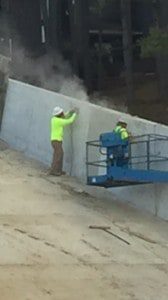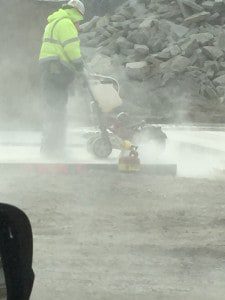Wait…what’s silica again?
Silica is a major component of sand, rock, and mineral ores—materials that are used on job sites all over the world. Respirable crystalline silica refers to airborne particles containing the minerals quartz,  cristobalite, and/or tridymite that can be inhaled.
cristobalite, and/or tridymite that can be inhaled.
What’s the big deal?
Well, for starters, crystalline silica is a human lung carcinogen. Prolonged inhalation of respirable crystalline silica can also result in silicosis, a disease characterized by progressive scarring of the lungs. Silicosis can mean shortness of breath and impaired lung function, which may eventually lead to lung infections and even death. The development and the severity of silicosis depends on two things: 1) the concentration of silica dust to which a worker is exposed and 2) the duration of exposure. Crystalline silica may be harmful following high exposure levels over a short period (a few weeks or years) or after long-term exposure at lower levels.
Where do I find it?
On construction sites! Silica is the primary component of many construction materials. Some commonly used construction materials containing silica include:
- Abrasives used for blasting;
- Brick, refractory work;
- Concrete, concrete block, cement, mortar;
- Granite, sandstone, quartzite, slate;
- Mineral deposits;
- Rock and stone;
- Sand, fill di
rt, top soil; and - Asphalt containing rock or stone.
What does OSHA require my company to do?
Your “to-do” list for silica has two main parts: a person and a plan.
- You need to get yourself a “silica-competent person.” You might be wondering where you’ll find one of those. Well, OSHA 1926.1153 defines a compent person as an employee who 1) can identify existing and foreseeable respirable crystalline silica hazards in the workplace and 2) has the authority to take prompt corrective measures to eliminate or minimize them. The employer should choose the most suitable person or persons at each job site to serve as the OSHA-competent person for each required regulation. It’s perfectly OK to have multiple OSHA-competent persons on a job site, each overseeing a different regulation. You can even have multiple competent persons for a single regulation to provide overlap, particularly for larger job sites; when there is a need to cover multiple shifts; when there is a need for timely coordination with other trades; to increase support at the start of a new project; or to oversee heavy use of regulated materials. Don’t forget: The employer must officially designate the competent person and provide this person the authorization to take prompt corrective measures.
- You need a written exposure control plan. This plan is for the competent person, who oversees its implementation. The competent person should be part of the team drafting this plan in order to provide information about the worksite tasks and materials, equipment, conditions, processes, and other vital details. If the employer develops a written exposure control plan that incorporates the alternative exposure control methods section of the regulation, a CIH is recommended to oversee monitoring and sampling activities.
The accuracy of the written exposure control plan is critical. While there is no set format required by OSHA, the plan must include a description of the tasks that may result in exposures, engineerin g controls, directions for how to do the work properly, equipment to be used, factors that influence exposure, and respiratory protection requirements. Workers must refer to this plan for guidance.
g controls, directions for how to do the work properly, equipment to be used, factors that influence exposure, and respiratory protection requirements. Workers must refer to this plan for guidance.
Can I get a recap?
- Respirable crystalline silica exposure can cause silicosis, which can lead to many serious health complications and even death.
- Crystalline silica is harmful in all doses—from high exposure levels over the course of a couple weeks or months, to small concentrations over a prolonged period.
- The employer must officially designate the competent person and provide this person the knowledge and authorization to take prompt corrective measures.
- A written exposure control plan must be implemented and available.
